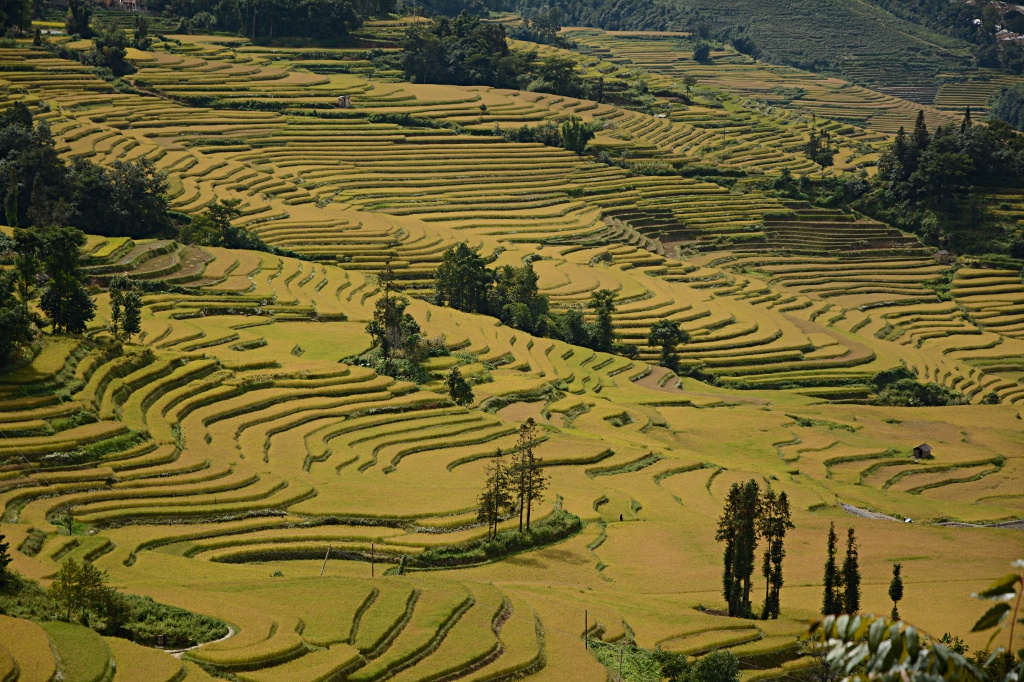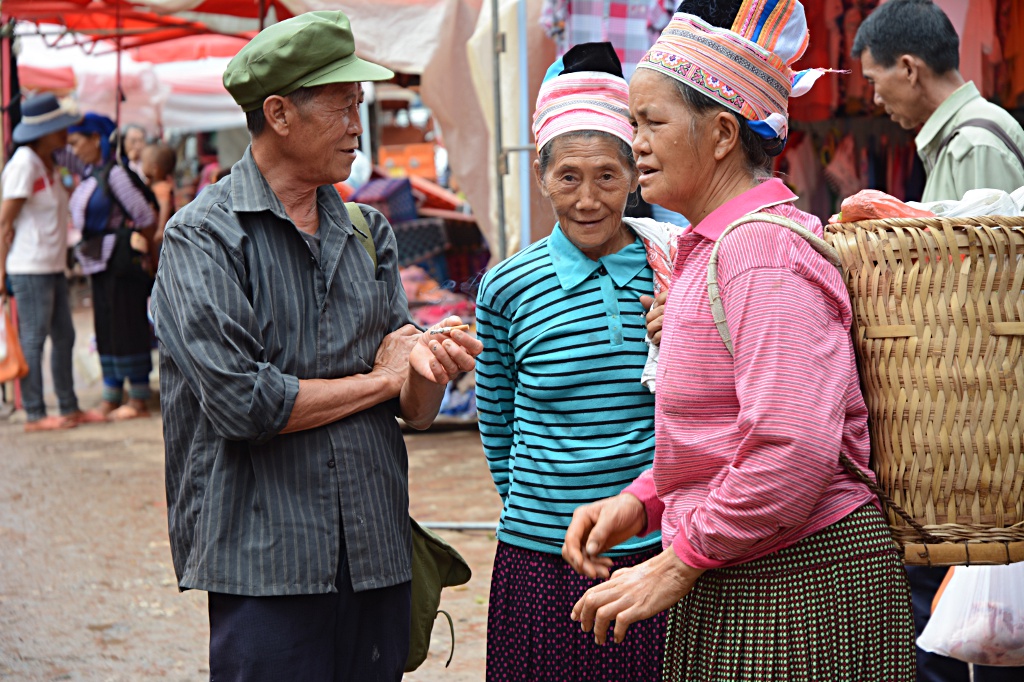Following our excursion to the Guizhou province, a less visited province in China, we headed back to the more common tourist trails in the south-western province Yunnan. While our day in Kunming mainly served administrative purposes, we quickly headed on to the mountains in the southeast of the province. Besides the world-famous rice-terraces, Yuanyang offers many minorities in a very small space. We completed our visit with a monster bus tour through the mountains and small villages.
Having seen the overpowering waterfalls of Huangguoshu, we continued our travels on September 11 just after 7am by taking the train from the city of Anshun to Kunming. The capital of Yunnan province was a long set intermediate stop, since we planned to organize our visa for Laos among a few other things. Ahead of schedule we reached the city in the middle of the afternoon, dropped our luggage off at the left-luggage office and caught a taxi to the Lao consulate. We had to learn the hard way however that the Yunnan government had taken over the former Camelia Hotel and everyone had been moved out. Unfortunately we didn’t have a new address at hand, but the security guard was kind enough to explain where we could now get the visa.
In the Overseas Hotel, to which we were pointed, we ran into Mr. Chen, who explained to us that there was nothing easier than organizing a visa for Laos. Of course he could help us for a considerable amount of money. Since we had no idea where to find the Lao consulate we decided to accept his offer and left our passports with him. He informed us that we could pick the passports up just about 24 hours later. We left his office and started our search for a place to stay for the following two nights. After checking quite a number of hotels near the train station we finally found a room which met all our criteria. While picking up our backpacks at the train station we had time to observe all the security measures now in place at Kungming train station. The blinded vehicle with constantly running engine which is prominently parked directly in front of the station. We assumed this police presence is a result of the knive attacks from last year at Kunming railway station.
The following day we stocked up on supplies for the following weeks in Laos, as well as taking care of a few more administrative things. Finally we did have a little time for sight-seeing which led us to visit a few places we didn`t have in mind. For example we visit a very nice flower market which was absolutely not what we had in mind. It still turned out to be very nice and the surrounding stalls in the streets also were quite interesting. Just in time for dinner we stumbled upon the market we had originally been looking for, just to discover colored chicks and puppies. Quite a bit touristy…
Once of the things we got done was the purchase of bus tickets to the Yuanyang rice-terraces in the south-east of the province. The bus took roughly 7 hours to the village of Xinjie, the transport hub at the entrance of the area.
Once we arrived, we were immediately surrounded by touts trying to sell transport to the villages in the back of the scenic area as well as owners of guesthouses. We followed Belinda who seemed to have a decent offer for a place to stay in Xinjie, took a look at the room negotiated the price and finally stayed. Unfortunately the nice morning view did not materialize on any of the following days due to thick clouds.
Before we started our load of laundry that night, we were asked by David, an Austrian from Vienna, whether we were interested in joining him and his guide to visit the Sunday market in Laomeng the next day. The market boasts the presence of up to 8 minority people out of 55 in China. Due to the fact that we like markets in general and this seemed to be a real gem, we quickly came to an agreement and joined the trip.
We spent a large part of the cloudy and rainy in the minibus to reach Laomeng. However the trip was definitely worth it: while the offerings on the market was quite regular, the visitors and stall owners turned out to be quite something else. Most of the people were wearing their traditional dresses. While we learned to identify some of them rather easily, we did not manage to distinguish all the different minorities. What we did observe was the combination of traditional and modern clothing however. Some of the dresses were based on a blouse bought from any stall, decorated with the typical sleeves and neck portions. Very creative!
On the way back to Xinjie we made a small detour to finally visit the Yuanyang rice-terraces. Through Laohuzui we finally made it to the top village of Duoyishu. The best view for us in the late afternoon turned out to be from a platform just below Bada village. The yellow rice fields in the afternoon sun covered the mountains just like a carpet. Lenka and I decided to hop of the bus near Quanfuzhuang to explore the rice fields and villages on foot. The well kept walking trail, or much more highway, is very well marked and of course also consists of many stairs. Without any incident we made our way to Qingkou village where we hopped on a tri-shaw to return to Xinjie where we enjoyed a delicious dinner in the restaurant of Belinda`s brother-in-law.
In the evening we checked the best way to make it from Yuanyang to the border post at Mohan to cross into Laos. Since a new road had recently opened between Nansha and Lvchun, we decided to catch the 7:30 am bus from Xinjie to Nansha from where we continued on to Lvchun. Depending on whether we would make the connection to Jiangchen the same day we would possibly overnight in Lvchun.
Fortunately we still made the connection despite the bus from Jianshui bound for Lvchun having 40 minutes delay. It was unfortunate that the 2:30 pm bus for Jiangcheng for which he had bought our tickets left after the 3 pm bus, but the driver made up for up. He passed the later bus to arrive first in Jiangcheng.
Besides the impressive driving style of the bus driver there was a lot more keeping us captivated. Once we had left the area of the rice terraces we reached broad and deep valleys. Thanks to the new road we traveled quickly and comfortably. After Lvchun, the rice fields and banana plantations made room for tea plantations, but never entirely disappeared. From far away, the tea plantations looked like more terraced fields, but looking closer one could identify that the dark color was actually bushes and not terraces. Across many passes and along a few ridges we finally reached Jiangcheng at 9 pm.
We couldn’t even leave the bus station before we were approached by an older lady asking whether we needed accommodation. Of course we did and it turned out that her offer was really acceptable, room-wise and price-wise. How often are you offered a hotel room for 5 Euros?
After a long day of traveling we didn’t know what to expect on the remaining stretch before reaching the Chinese-Lao border. It turned out that the trip from Jiangcheng to Mengla took another 6 hours. Similar to the day before, the changing landscape was one of the key factors to stay awake. When we saw the road sign for the turn-off to Pu`er, we realized where exactly we were and how important that region is as a tea growing area.
Once we had arrived in Mengla, we calmly started inquiring for means of transport to Laos. Since it was already 2 pm, we assumed that we would catch the morning bus the next day to cross the border. The lady at the ticket counter explained that she would only know at 8 am whether there were still seats on the bus available. The bus to Muang Sing used a border crossing which was not open to non-Chinese and non-Lao. We finally made the quick decision to grab the bus leaving the same afternoon, which meant we had to be fast since the bus would be leaving 15 minutes later. The border crossing was absolutely painless and even getting a visa on arrival proved to be painless for Simon, a French traveler on the same bus. Around 5 pm local time (Laos is 1 hours behind China) we set foot on Lao soil in Luang Namtha having spend 18.5 hours net on buses in the previous two days. These two days in summary:
- 07:30 am: Departure in Yuanyang, Xinjie (新街镇)
- 08:40 am: Arrival in Yuanyang, Nansha (南沙镇)
- 10:00 am: Departure from Yuanyang, Nansha to Lvchun (绿春县)
- 12:00 pm: Arrival in Lvchun
- 03:10 pm: Departure from Lvchun to Jiangcheng (江城)
- 09:00 pm: Arrival in Jiangcheng
- 07:20 am: Departure from Jiangcheng to Mengla (勐腊县)
- 02:00 pm: Arrival in Mengla
- 02:30 pm: Departure from Mengla to the Chinese-Lao border
- 05:00 pm: Arrival in Luang Namtha
It didn’t take long to chose one out of the many guesthouse such that we could focus on the first Beerlao and a dinner on the night market.












